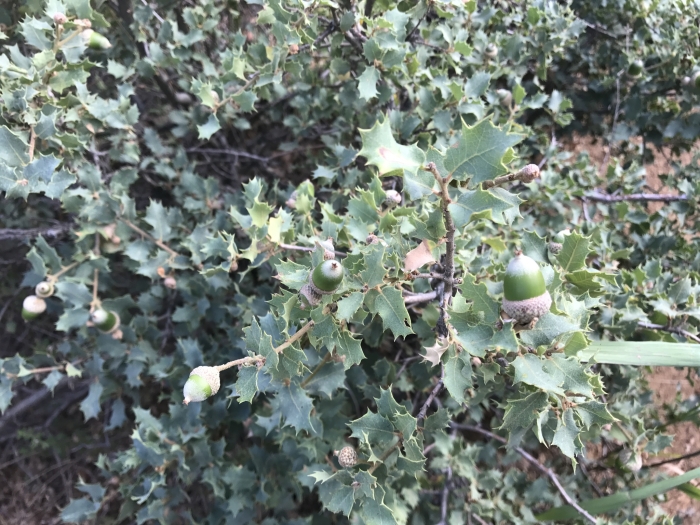Shrub Oak
(Quercus turbinella)
Shrub Oak (Quercus turbinella)
/
/

CK Kelly
CC BY 4.0
Image By:
CK Kelly
Recorded By:
Copyright:
CC BY 4.0
Copyright Notice:
Photo by: CK Kelly | License Type: CC BY 4.0 | License URL: http://creativecommons.org/licenses/by/4.0/ | Rights Holder: CK Kelly | Publisher: iNaturalist | Date Created: 2017-08-03T22:33:19Z |






















































Estimated Native Range
Summary
Quercus turbinella, commonly known as Shrub Oak, is an evergreen shrub that can occasionally take on a treelike form, reaching heights exceeding 6 meters (20 feet). It is native to the chaparral and woodlands of the southwestern United States, California and Baja California. The typical height for this species is between 2–5 meters (6+1⁄2–16+1⁄2 feet), with a dense and rounded habit that provides substantial cover for wildlife. The leaves of the Shrub Oak are thick, leathery, and evergreen, measuring up to 3 centimeters (1+1⁄4 inches) in length and 2 cm (3⁄4 in) in width. They have a distinctive gray-green to yellowish color on the upper surface and are yellowish, hairy, or woolly and glandular on the lower surface. The foliage is edged with large, spine-tipped teeth, which can be a deterrent to browsing animals.
Shrub Oak is valued for its drought tolerance and ability to thrive in poor, rocky soils, making it suitable for xeriscaping and naturalistic plantings in arid regions. It is also used for erosion control and as a windbreak due to its robust root system. In cultivation, it requires full sun exposure and well-drained soils, with medium water requirements. While it reproduces sexually via acorns when moisture is sufficient, it more commonly regenerates vegetatively through sprouting from its rhizome and root crown. Gardeners should be aware that this oak can become a fire hazard in certain conditions due to its dense growth and the flammability of chaparral vegetation.CC BY-SA 4.0
Shrub Oak is valued for its drought tolerance and ability to thrive in poor, rocky soils, making it suitable for xeriscaping and naturalistic plantings in arid regions. It is also used for erosion control and as a windbreak due to its robust root system. In cultivation, it requires full sun exposure and well-drained soils, with medium water requirements. While it reproduces sexually via acorns when moisture is sufficient, it more commonly regenerates vegetatively through sprouting from its rhizome and root crown. Gardeners should be aware that this oak can become a fire hazard in certain conditions due to its dense growth and the flammability of chaparral vegetation.CC BY-SA 4.0
Plant Description
- Plant Type: Shrub, Tree
- Height: 6-15 feet
- Width: 4-8 feet
- Growth Rate: Moderate
- Flower Color: N/A
- Flowering Season: Spring
- Leaf Retention: Evergreen
Growth Requirements
- Sun: Full Sun
- Water: Medium
- Drainage: Fast, Medium
Common Uses
Bee Garden, Bird Garden, Butterfly Garden, Low Maintenance, Rabbit Resistant
Natural Habitat
native to the chaparral and woodlands of the southwestern United States, California and Baja California
Other Names
Common Names: Scrub Oak, Shrub Live Oak, Turbinella Oak, Scrub Live Oak, Sonoran Scrub Oak, Turbinella Oak, Gray Oak
Scientific Names: , Quercus turbinella, Quercus turbinella subsp. turbinella, Quercus subturbinella, Quercus turbinella var. turbinella, Quercus dumosa var. turbinella, Quercus dumosa subsp. turbinella,
GBIF Accepted Name: Quercus turbinella Greene